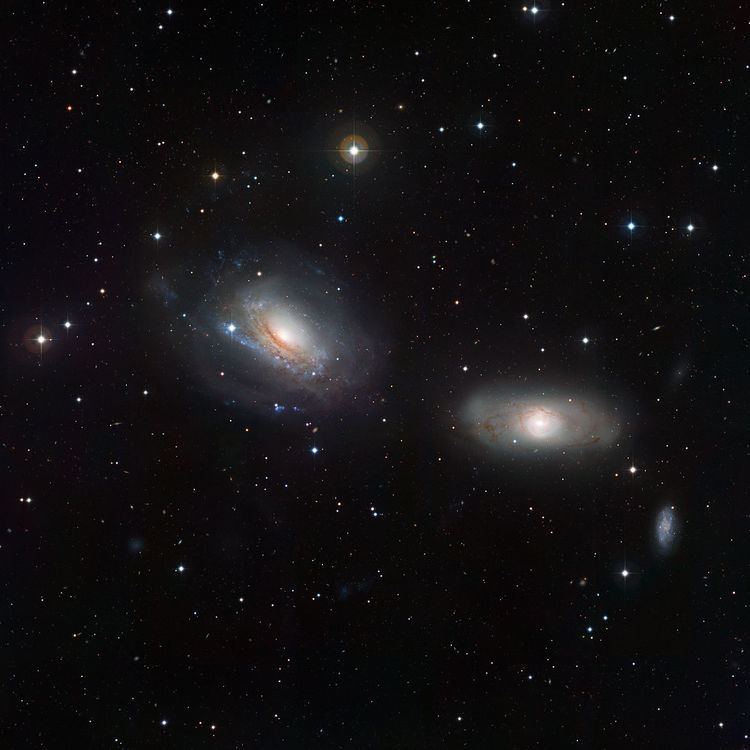 | ||
Interacting galaxies (colliding galaxies) are galaxies whose gravitational fields result in a disturbance of one another. An example of a minor interaction is a satellite galaxy's disturbing the primary galaxy's spiral arms. An example of a major interaction is a galactic collision, which may lead to a galaxy merger.
Contents
Satellite interaction
A giant galaxy interacting with its satellites is common. A satellite's gravity could attract one of the primary's spiral arms, or the secondary satellite's path could coincide with the position of the primary satellite's and so would dive into the primary galaxy (the Sagittarius Dwarf Elliptical Galaxy into the Milky Way being an example of the latter). That can possibly trigger a small amount of star formation.
Galaxy collision
Colliding galaxies are common during galaxy evolution. The extremely tenuous distribution of matter in galaxies means these are not collisions in the traditional sense of the word, but rather gravitational interactions.
Colliding may lead to merging if two galaxies collide and do not have enough momentum to continue traveling after the collision. In that case, they fall back into each other and eventually merge into one galaxy after many passes through each other. If one of the colliding galaxies is much larger than the other, it will remain largely intact after the merger. The larger galaxy will look much the same, while the smaller galaxy will be stripped apart and become part of the larger galaxy. When galaxies pass through each other, unlike during mergers, they largely retain their material and shape after the pass.
Galactic collisions are now frequently simulated on computers, which use realistic physics principles, including the simulation of gravitational forces, gas dissipation phenomena, star formation, and feedback. Dynamical friction slows the relative motion galaxy pairs, which may possibly merge at some point, according to the initial relative energy of the orbits. A library of simulated galaxy collisions can be found at the Paris Observatory website: GALMER
Galactic cannibalism
Galactic cannibalism refers to the process in which a large galaxy, through tidal gravitational interactions with a companion, merges with that companion; that results in a larger, often irregular galaxy.
The most common result of the gravitational merger between two or more galaxies is an irregular galaxy, but elliptical galaxies may also result.
It has been suggested that galactic cannibalism is currently occurring between the Milky Way and the Large and Small Magellanic Clouds. Streams of gravitationally-attracted hydrogen arcing from these dwarf galaxies to the Milky Way is taken as evidence for the theory.
Galaxy harassment
Galaxy harassment is a type of interaction between a low-luminosity galaxy and a brighter one that takes place within rich galaxy clusters, such as Virgo and Coma, where galaxies are moving at high relative speeds and suffering frequent encounters with other systems of the cluster by the high galactic density of the latter. According to computer simulations, the interactions convert the affected systems into disturbed barred spiral galaxies and produces starbursts on them followed, if more encounters occur, by loss of angular momentum and heating of their gas.
The result would be the conversion of (late type) low-luminosity spiral galaxies into dwarf spheroidals and dwarf ellipticals.
Evidence for the hypothesis has been found by studying early-type dwarf galaxies of the Virgo Cluster and finding structures, such as disks and spiral arms. That suggests they are former disk systems, transformed by the mentioned interactions.
Future collision of the Milky Way with Andromeda
Astronomers have estimated the Milky Way galaxy, will collide with the Andromeda galaxy in about 4.5 billion years. It is thought that the two spiral galaxies will eventually merge to become an elliptical galaxy or perhaps a large disk galaxy.
